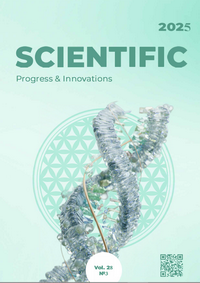Carbohydrate-lipid metabolism in piglets exposed to iron and germanium nano-compounds
DOI:
https://doi.org/10.31210/spi2025.28.03.28Keywords:
pigs, iron nano-compounds, germanium nano-compounds, carbohydrate metabolism, lipid metabolism, post-natal adaptationAbstract
A complex assessment was carried out to evaluate the effects of iron and germanium nano-compounds on energy metabolism in sows and the post-natal adaptation of their piglets. The objective was to determine how administering daily doses of iron (3 mg) and germanium (0.01 mg) nano-compounds to sows starting 10 days before farrowing influences carbohydrate and lipid metabolism indicators in the blood of their offspring. For this purpose, 24 sows of Large White breed were equally divided into the experimental and control groups (n=12). Piglet blood from the two groups was sampled on the 2, 7, and 21 day of life to determine the concentrations of glucose, lactate, pyruvate and non-esterified fatty acids (NEFA). The statistical processing was conducted using one-factor and two-factor ANOVA (P≤0,05). It was found that in 2-day-old piglets from the experimental group, the level of lactate increased by 24.1 % (P<0.001), the lactate/pyruvate ratio decreased by 26.0 % (P<0.001), and at the same time glucose and NEFA concentrations fell by 5.3-6.5 % (P=0.05–0.01), while triacylglycerol (TAG) and total cholesterol rose by 9.3-9.8 % (P<0.01). Seven-day-old piglets displayed a 16.9 % reduction in lactate/pyruvate ratio (P<0.001) accompanied by the increased pyruvate content, and 21-day-old piglets showed moderate increases in both lactate and pyruvate with a significant decrease in their ratio (P<0.05). Lipid metabolism in 7-day-old piglets was marked by 16.7-22.3 % increases in TAG and cholesterol levels in blood plasma (P<0.001), whereas NEFA content tended to decline. Two-factor ANOVA confirmed statistically significant nano-compound effects on lactate content (F=13.6; P<0.01, TAG (F=28.8; P<0.001), cholesterol (F=8.5; P<0.01) ), and lactate/pyruvate ratio in blood plasma (F=24.2; P<0.001). The results indicate an activation of carbohydrate and lipid metabolism in sows under the influence of iron and germanium nano-compounds, as well as improved metabolic readiness of piglets for post-natal adaptation. This opens up prospects for the use of these nano-complexes to enhance the productivity and resilience of pig stock.
Downloads
Published
How to Cite
Issue
Section
License
Copyright (c) 2025 Scientific Progress & Innovations

This work is licensed under a Creative Commons Attribution 4.0 International License.

 Creative Commons Attribution 4.0 International Licens
Creative Commons Attribution 4.0 International Licens